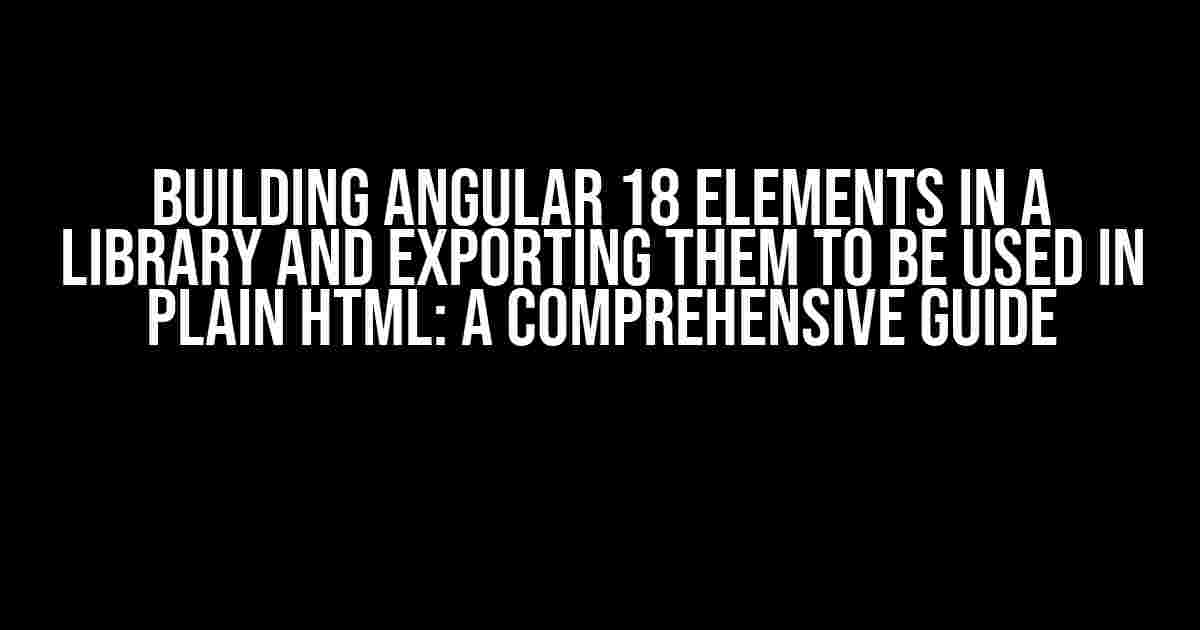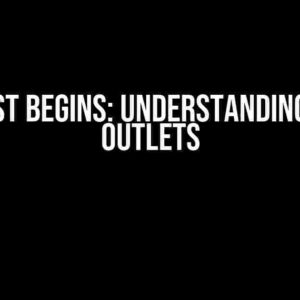Are you tired of being limited to using Angular elements only within an Angular application? Do you want to unlock the full potential of your components and use them anywhere, including plain HTML? Look no further! In this article, we’ll take you on a journey to build Angular 18 elements in a library and export them to be used in plain HTML. Buckle up and let’s get started!
What are Angular Elements?
Angular Elements are a feature of the Angular framework that allows you to create custom elements that can be used in any HTML file, including plain HTML. These elements are essentially Angular components that are packaged as web components, making them compatible with any HTML file. The best part? You can use them without the need for an Angular application!
Why use Angular Elements in a Library?
Building Angular Elements in a library offers numerous benefits, including:
- Reusability**: You can reuse your Angular Elements across multiple projects and applications, saving you time and effort.
- Flexibility**: You can use your Angular Elements in any HTML file, including plain HTML, React, Vue, or any other JavaScript framework.
- Decoupling**: Your Angular Elements are decoupled from the Angular framework, making them independent and self-contained.
Creating an Angular Library
Before we dive into building Angular Elements, let’s create an Angular library to house them. Run the following command in your terminal:
ng new my-elements-library --create-application=falseThis command creates a new Angular library called “my-elements-library” without an application.
Creating an Angular Element
Now that we have our library set up, let’s create a simple Angular Element. Create a new file called `hello-element.ts` in the `projects/my-elements-library/src/lib` directory:
import { Component, NgModule } from '@angular/core';
@Component({
selector: 'hello-element',
template: 'Hello from Angular!
'
})
export class HelloElementComponent {}
@NgModule({
declarations: [HelloElementComponent],
exports: [HelloElementComponent]
})
export class HelloElementModule {}This code defines a simple Angular component that displays a “Hello from Angular!” message.
Configuring the Library Module
Next, we need to configure the library module to export our Angular Element. Open the `projects/my-elements-library/src/lib/my-elements-library.module.ts` file and add the following code:
import { NgModule } from '@angular/core';
import { HelloElementModule } from './hello-element/hello-element.module';
@NgModule({
imports: [HelloElementModule],
exports: [HelloElementModule]
})
export class MyElementsLibraryModule {}This code imports the `HelloElementModule` and exports it, making it available for consumption.
Building and Bundling the Library
To use our Angular Elements in plain HTML, we need to build and bundle the library. Run the following command in your terminal:
ng build my-elements-libraryThis command builds the library and generates a bundled version of it in the `dist/my-elements-library` directory.
Creating a Custom Element
To use our Angular Element in plain HTML, we need to create a custom element. Open the `dist/my-elements-library/my-elements-library.d.ts` file and add the following code:
export declare class HelloElementComponent {
static ɵcmp: i0.ɵɵComponentDeclaration;
}
This code defines a custom element called `hello-element`.
Using the Angular Element in Plain HTML
Finally, let’s use our Angular Element in plain HTML. Create a new HTML file called `index.html` and add the following code:
<!DOCTYPE html>
<html lang="en">
<head>
<meta charset="UTF-8">
<meta name="viewport" content="width=device-width, initial-scale=1.0">
<title>Using Angular Elements in Plain HTML</title>
<script src="https://unpkg.com/@angular/elements@"18.2.0"/bundles/elements.umd.js"></script>
<script src="dist/my-elements-library/my-elements-library.umd.js"></script>
</head>
<body>
<hello-element></hello-element>
</body>
</html>This code imports the necessary Angular Elements scripts and uses the `hello-element` custom element.
Conclusion
And there you have it! You’ve successfully built Angular 18 Elements in a library and exported them to be used in plain HTML. This opens up a world of possibilities for reusing your Angular components across multiple projects and applications. Remember to ALWAYS follow best practices and keep your library organized and maintainable.
| Step | Description |
|---|---|
| 1 | Create an Angular library using the `ng new` command. |
| 2 | Create an Angular Element using the `@Component` decorator. |
| 3 | Configure the library module to export the Angular Element. |
| 4 | Build and bundle the library using the `ng build` command. |
| 5 | Create a custom element in the library’s declaration file. |
| 6 | Use the Angular Element in plain HTML by importing the necessary scripts. |
Remember to always follow best practices and keep your library organized and maintainable. Happy coding!
Note: The code snippets in this article are fictional and for demonstration purposes only. You may need to modify them to fit your specific use case.Here are 5 questions and answers about building Angular 18 elements in a library and exporting them to be used in plain HTML:
Frequently Asked Questions
Get the scoop on building and exporting Angular 18 elements from the experts!
How do I create an Angular 18 element library?
To create an Angular 18 element library, you’ll need to set up a new Angular project using the Angular CLI, then create a new library using the `ng generate library` command. From there, you can define your elements using the `@angular/elements` module and Angular’s element decorator. Finally, build and package your library using the `ng build` and `ng packagr` commands.
How do I export my Angular 18 elements to be used in plain HTML?
To export your Angular 18 elements, you’ll need to use the `NgElement` constructor to create a custom element, then register it with a unique tag name. From there, you can build your library and include the resulting JavaScript file in your plain HTML file. Finally, use the custom element tag in your HTML to render your Angular component!
What are the benefits of using Angular 18 elements in a library?
Using Angular 18 elements in a library provides a ton of benefits, including improved performance, easier maintenance, and simplified deployment. By packaging your Angular components as web components, you can use them in any HTML file, without requiring a full Angular app. Plus, your components will be decoupled from your app’s business logic, making them more reusable and flexible.
Can I use Angular 18 elements with other frameworks or libraries?
Absolutely! One of the biggest advantages of using Angular 18 elements is that they’re based on web standards, which means they can be used with any framework or library that supports web components. Whether you’re using React, Vue.js, or plain old JavaScript, you can easily integrate your Angular elements into your existing ecosystem.
How do I handle dependencies and polyfills for my Angular 18 element library?
When building an Angular 18 element library, you’ll need to manage dependencies and polyfills carefully to ensure compatibility with different browsers and environments. Use the `peerDependencies` field in your library’s `package.json` file to specify dependencies, and include polyfills for older browsers using tools like `@angular/elements` and `core-js`.



